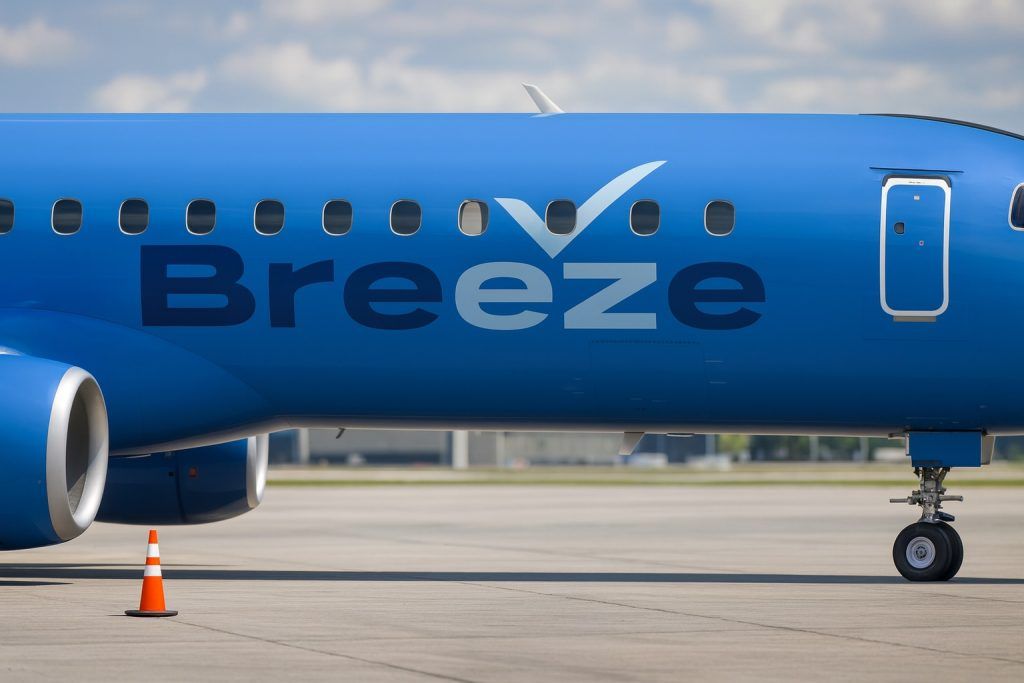As of November 18, 2025, Nvidia (NVDA) sits at the center of a global bet on artificial intelligence — and some of the world’s most influential investors are quietly heading for the exits.
Nvidia stock is under pressure as Peter Thiel’s fund, SoftBank and other elite investors sell out ahead of key earnings. Options markets point to a historic $320 billion swing while AI bubble warnings grow louder. Here’s what’s driving the latest Nvidia sell-off and what it could mean for the AI rally.
Key Takeaways
- Peter Thiel’s hedge fund, Thiel Macro, has sold its entire Nvidia stake — roughly 537,000 shares — worth about $100 million as of September 30, according to SEC filings. [1]
- SoftBank has also exited Nvidia, selling a $5.8 billion stake to free up cash for a planned $22.5 billion investment in OpenAI. [2]
- Options markets are pricing in a roughly 7% move in Nvidia’s stock after Wednesday’s earnings, implying a record $320 billion swing in market value. [3]
- Nvidia’s results are expected to show Q3 revenue jumping around 56% to about $55 billion, even as concerns grow that AI valuations have outrun fundamentals. [4]
- Top investors and tech leaders — from Michael Burry and Jeffrey Gundlach to Google CEO Sundar Pichai — are openly warning about AI bubble risks. [5]
Nvidia’s High-Wire Moment in the AI Boom
Nvidia has become the purest proxy for the AI revolution. Its GPUs power everything from large language models to hyperscale data centers, and the stock has rocketed more than 1,200% over the past three years, making it the world’s most valuable publicly listed company with a market value around $4.6–5 trillion. [6]
Yet the mood around the stock on November 18, 2025 is anything but calm:
- Nvidia shares are up about 38% so far this year, but they’ve fallen roughly 10% from record highs set in late October and are down around 8% in November as investors reassess frothy AI valuations. [7]
- As of midday Tuesday (UTC), NVDA was trading in the high-$180s, off roughly 2% on the session, ahead of earnings.
- Options markets suggest a ~7% move in either direction after Nvidia reports on Wednesday, which translates into a potential $320 billion one-day swing in market value — the largest post-earnings move ever for the company. [8]
That kind of volatility would be extraordinary for any stock, let alone a company that now represents about 8% of the S&P 500. [9] Wall Street strategists increasingly describe Nvidia as the “anchor” of the AI capital expenditure trade: whichever way it moves after earnings could ripple across trillions of dollars in related bets, from semiconductor names to cloud giants.
Peter Thiel’s Fund Walks Away from AI’s Poster Child
The most eye‑catching move comes from Peter Thiel, the billionaire tech investor and co‑founder of PayPal and Palantir.
According to a recent 13F filing, Thiel’s hedge fund Thiel Macro sold all 537,742 Nvidia shares it held during the third quarter of 2025. At Nvidia’s September 30 closing price, that stake would have been worth roughly $100 million. [10]
Reuters reports that the exit intensifies Wall Street’s fears that the AI boom may be morphing into a bubble. [11] Separate analysis of the 13F data shows that Thiel’s fund:
- Shrank its overall equity book by roughly two-thirds,
- Concentrated what remains in Apple, Microsoft and a reduced Tesla position, making them its core long holdings. [12]
A syndicated version of the Yahoo Finance piece on Thiel’s 13F notes that this was not a simple rebalance but a “full‑blown exit” from Nvidia at a moment when many analysts still view the stock as untouchable. [13]
Thiel has previously warned that the AI hype cycle is running ahead of its underlying economics. His portfolio now seems to reflect that skepticism: he’s still exposed to Big Tech platforms, but he’s stepping away from the pure‑play chipmaker that sits at the heart of the AI build‑out.
SoftBank Cashes Out of Nvidia to Double Down on OpenAI
Thiel isn’t alone. SoftBank Group — one of the most aggressive backers of the AI ecosystem — has also exited Nvidia.
In an earnings presentation last week, SoftBank disclosed that it sold its entire remaining 32.1 million‑share Nvidia stake, raising about $5.83 billion. The company said the sale was explicitly intended to free up capital for a $22.5 billion investment in OpenAI, increasing its stake in the ChatGPT maker from roughly 4% to an estimated 11%. [14]
Key details from SoftBank’s move: [15]
- The Nvidia sale is part of a broader “asset monetization” strategy, including trimming its T‑Mobile stake and leveraging its Arm Holdings position.
- SoftBank executives say the deal is not necessarily a bearish call on Nvidia, but a way to fund massive AI infrastructure bets — such as OpenAI’s proposed $500 billion Stargate data center initiative — while preserving balance sheet flexibility.
- It’s actually the second time SoftBank has fully cashed out of Nvidia after a big run‑up, having previously built and exited a multibillion‑dollar stake between 2017 and 2019.
Still, the optics matter. When a major AI beneficiary recycles a $5.8 billion Nvidia windfall into AI software and infrastructure, it supports the perception that some insiders think the easy money in Nvidia’s stock may already have been made, even if they remain bullish on AI overall.
CNN’s “Elite Investors” Theme: A Broader Shift in Sentiment
A CNN Business analysis — widely syndicated across financial portals — frames the story more broadly: three prominent investors with very different styles have all been dumping Nvidia at the same time, turning on what it calls “the darling of the AI rally.” [16]
While the full list varies by outlet, the theme is consistent:
- Peter Thiel’s Thiel Macro has walked away entirely from Nvidia. [17]
- SoftBank CEO Masayoshi Son has also exited, reallocating proceeds to OpenAI and other AI infrastructure plays. [18]
- Other high‑profile investors have turned vocal skeptics of AI‑driven valuations, even if they differ on how much of a bubble exists.
One of those is “Big Short” investor Michael Burry, who has placed a bet against Nvidia and warned that cloud providers are flattering earnings by extending the depreciable life of AI hardware such as Nvidia’s chips. [19]
Another is bond king Jeffrey Gundlach, who has compared today’s AI‑powered stock boom to the late‑1990s dot‑com bubble and warned of potential economic pain if valuations reset sharply. [20]
Together, these moves underpin a new narrative: the AI trade may finally be maturing from euphoria into doubt, as investors who rode Nvidia’s meteoric rise start asking whether the risk‑reward still makes sense at multi‑trillion‑dollar valuations.
Google’s Sundar Pichai Adds to AI Bubble Warnings
The skepticism isn’t confined to Wall Street bears.
In a fresh interview with the BBC, highlighted by Reuters, Alphabet and Google CEO Sundar Pichai cautioned that if an AI bubble were to burst, no major company would escape the fallout. He described the current wave of AI investment as an “extraordinary moment” but acknowledged “elements of irrationality” in the market, echoing language used during the dot‑com era. [21]
Pichai’s warning lands at the same time that:
- AI‑linked stocks have led a multi‑year surge in global equities;
- Nvidia’s valuation has climbed into territory once reserved for entire sectors; and
- Bitcoin and other risk assets have turned volatile again as investors question whether financial conditions still justify extreme risk‑taking. [22]
Coming from the CEO of a company that is pouring tens of billions into AI, the message is striking: even AI’s biggest corporate beneficiaries are publicly acknowledging bubble risks.
The Numbers Behind Nvidia’s Next Earnings Test
Despite the high‑profile investor exits and bubble talk, Nvidia’s underlying business is still expanding at an astonishing pace.
Analysts expect the company to report on Wednesday that for the quarter ended in late October: [23]
- Revenue rose around 56% year‑on‑year to about $54.9 billion, down from earlier triple‑digit growth but still extraordinary for a company of this size.
- Net income likely grew about 53% to nearly $29.5 billion, even as the company invests heavily in new chip platforms.
- Nvidia’s adjusted gross margin is projected to dip to roughly 73.6%, squeezed by the complexity and cost of ramping next‑generation architectures like Blackwell and the upcoming Rubin line.
- CEO Jensen Huang has told investors the company already has roughly $500 billion in chip bookings through 2026, underscoring just how long and deep the AI demand pipeline may be.
- Nvidia has also committed around $100 billion to invest in OpenAI and taken a $5 billion stake in Intel, raising fresh questions about how far it can stretch its balance sheet while still rewarding shareholders.
At the same time, Nvidia faces tough geopolitical headwinds. U.S. export controls now prevent it from sending its most advanced AI chips to China, and the company has stripped China from its forecast for high‑end processors while it evaluates whether a scaled‑down Blackwell variant would be acceptable under U.S. rules. [24]
In short, the fundamental story remains powerful, but the margin for error is shrinking. That’s exactly why options traders are bracing for a historic move when earnings hit.
Why Thiel and SoftBank’s Exits Matter — Symbolically More Than Financially
In absolute terms, Thiel Macro’s $100 million position and SoftBank’s $5.8 billion sale are small relative to a $4.6+ trillion company. Even both combined represent a tiny fraction of Nvidia’s market capitalization. [25]
However, markets care as much about signal as size:
- Thiel is widely viewed as a contrarian with a strong track record in spotting tech regime shifts. When someone like that liquidates an entire position — instead of just trimming — investors take notice. [26]
- SoftBank has been one of the loudest champions of AI, from its Arm stake to its Vision Fund portfolio and now its outsized OpenAI bet. Its decision to recycle Nvidia gains into AI infrastructure hints at a view that the ecosystem may have more upside than the stock at current prices. [27]
- CNN Business and other outlets are framing these moves as part of a broader shift among “elite investors” who are increasingly uncomfortable with Nvidia’s risk profile, even if they remain bullish on AI generally. [28]
On the other side of the ledger, fundamentally minded bulls point to:
- Persistent shortages of Nvidia’s most advanced chips;
- Multi‑year AI build‑out plans by hyperscalers like Microsoft, Amazon and Google; and
- The fact that Nvidia has beaten Wall Street estimates for 12 straight quarters, even as expectations rose sharply each time. [29]
This tug‑of‑war between stunning growth and sky‑high expectations is the central tension driving today’s volatility.
What Retail Investors Should Watch Next
Nothing in this article is personal investment advice, but there are a few concrete things any Nvidia watcher may want to keep an eye on in the coming days:
- Post‑Earnings Price Action
Does Nvidia’s move after earnings match the 7% swing implied by options, or do we see an even bigger reaction? A larger‑than‑expected drop could signal that the market was more fragile than valuations suggested; a massive rally would suggest bubble fears were overstated — at least for now. [30] - AI Demand Commentary vs. Bubble Talk
Listen carefully to what Nvidia says about:- Data center spending plans from cloud giants,
- The pace of AI model upgrades, and
- The lifecycle of its chips (how quickly they’re replaced or resold).
This will speak directly to concerns raised by Michael Burry and other skeptics about earnings being artificially smoothed by accounting choices and extended asset lives. [31]
- Capital Allocation and Balance Sheet Risks
Investors are already questioning how Nvidia’s $100 billion OpenAI commitment and $5 billion Intel stake will affect its flexibility. Watch for updated guidance on buybacks, dividends and further strategic investments. [32] - Signals from Other “Elite Investors”
In the coming 13F cycles and public interviews:- Do more hedge funds follow Thiel and SoftBank in trimming or exiting Nvidia?
- Or do long‑term investors treat any pullback as a buying opportunity?
A divergence — say, more short‑term money leaving while pension funds and insurance companies step in — would suggest the AI trade is entering a new phase rather than ending outright. [33]
- Macro and Big‑Tech Messaging on AI Risk
Sundar Pichai’s warning that no company will be untouched if an AI bubble bursts could be an early sign of more cautious messaging from Big Tech leaders. If others follow suit, it may cool speculative excess — or at least make investors more selective about which AI names they own. [34]
For now, Nvidia remains both the engine and the weathervane of the AI boom. The fact that some of the world’s most connected investors are stepping aside just as Wall Street braces for a record‑setting earnings reaction only heightens the stakes.
Whether this week marks the start of an AI comedown or the next leg higher will depend heavily on what Nvidia says — and how convincingly it can show that its growth story is still grounded in durable demand rather than market euphoria.
References
1. www.reuters.com, 2. siliconangle.com, 3. www.reuters.com, 4. www.reuters.com, 5. www.reuters.com, 6. www.reuters.com, 7. www.reuters.com, 8. www.reuters.com, 9. www.reuters.com, 10. www.reuters.com, 11. www.reuters.com, 12. m.wenxuecity.com, 13. m.wenxuecity.com, 14. siliconangle.com, 15. siliconangle.com, 16. finance.yahoo.com, 17. www.reuters.com, 18. www.reuters.com, 19. www.reuters.com, 20. en.wikipedia.org, 21. www.reuters.com, 22. www.theguardian.com, 23. www.reuters.com, 24. www.reuters.com, 25. www.reuters.com, 26. m.wenxuecity.com, 27. siliconangle.com, 28. finance.yahoo.com, 29. www.reuters.com, 30. www.reuters.com, 31. www.reuters.com, 32. www.reuters.com, 33. www.reuters.com, 34. www.reuters.com







